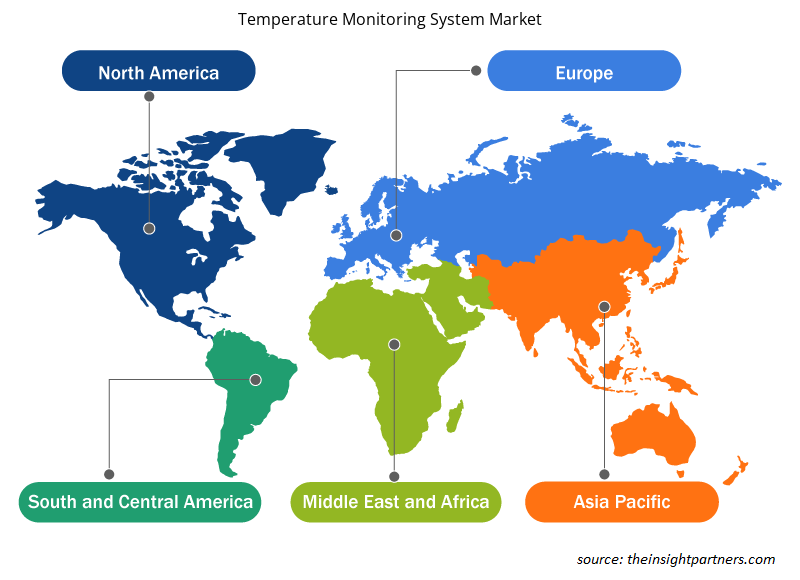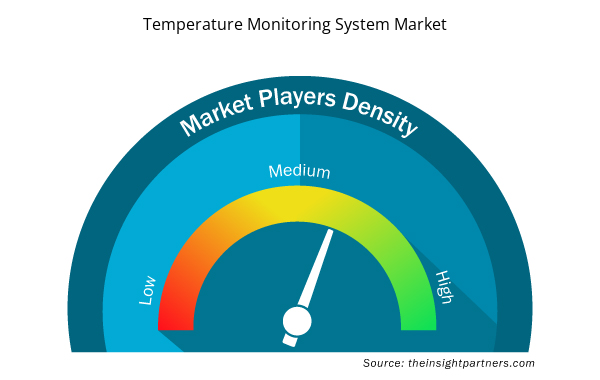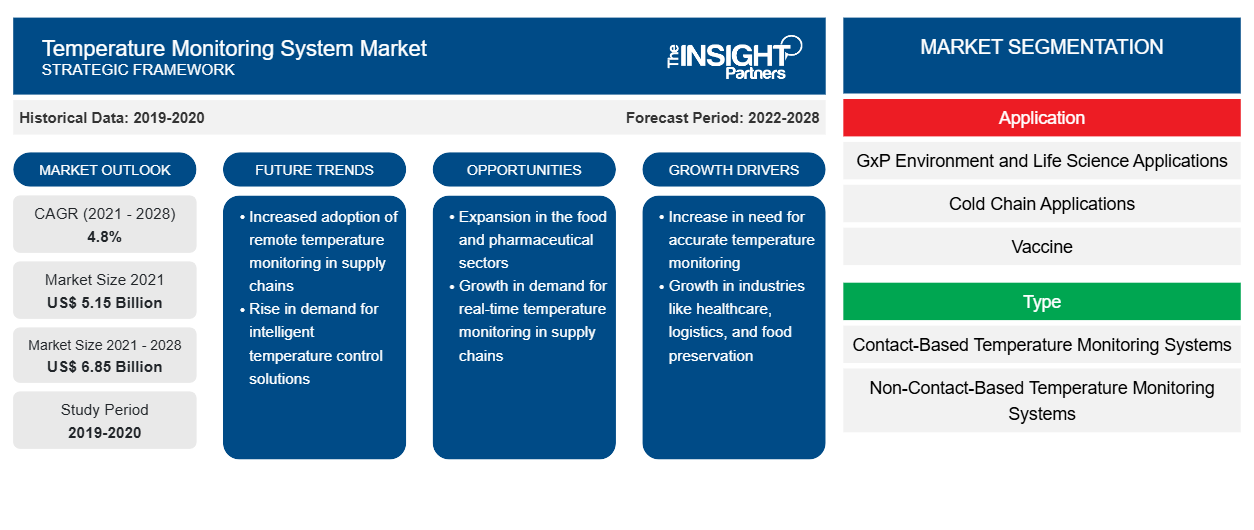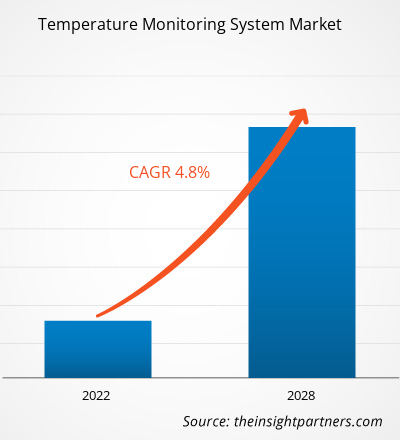من المتوقع أن ينمو سوق نظام مراقبة درجة الحرارة من 5.15 مليار دولار أمريكي في عام 2021 إلى 6.85 مليار دولار أمريكي بحلول عام 2028؛ ومن المتوقع أن ينمو بمعدل نمو سنوي مركب بنسبة 4.8٪ خلال الفترة من 2021 إلى 2028.
يتحكم نظام مراقبة درجة الحرارة وينظم درجة حرارة بيئة معينة. أصبح نظام مراقبة درجة الحرارة جزءًا أساسيًا من المستشفيات والعيادات وشركات الأغذية والصناعات الأخرى في السنوات الأخيرة. باستخدام نظام مراقبة درجة الحرارة، يمكن لأي شخص تتبع درجة حرارة المنتجات والتحكم فيها وتنظيمها بسهولة في بيئة معينة. يضمن نظام مراقبة درجة الحرارة أن المنتجات المعتمدة على درجة الحرارة تظل آمنة عند نقلها من مكان إلى آخر. يتم تقسيم سوق نظام مراقبة درجة الحرارة على أساس التطبيق والنوع والصناعات والجغرافيا. يتم تقسيم السوق، حسب الجغرافيا، على نطاق واسع إلى أمريكا الشمالية وأوروبا وآسيا والمحيط الهادئ والشرق الأوسط وأفريقيا وأمريكا الجنوبية والوسطى. يقدم التقرير رؤى متعمقة في سوق نظام مراقبة درجة الحرارة، مع التركيز على معايير مثل اتجاهات السوق والتقدم التكنولوجي وديناميكيات السوق، جنبًا إلى جنب مع تحليل المشهد التنافسي للاعبين الرائدين في السوق.
قم بتخصيص هذا التقرير ليناسب متطلباتك
ستحصل على تخصيص لأي تقرير - مجانًا - بما في ذلك أجزاء من هذا التقرير، أو تحليل على مستوى الدولة، وحزمة بيانات Excel، بالإضافة إلى الاستفادة من العروض والخصومات الرائعة للشركات الناشئة والجامعات
- احصل على أهم اتجاهات السوق الرئيسية لهذا التقرير.ستتضمن هذه العينة المجانية تحليلاً للبيانات، بدءًا من اتجاهات السوق وحتى التقديرات والتوقعات.
رؤى السوق
تساهم اللوائح الصارمة التي تحكم صناعات الأغذية والمشروبات والأدوية بشكل كبير في نمو سوق أنظمة مراقبة درجة الحرارة
تؤثر القضايا المتعلقة بدرجات الحرارة بشكل كبير على قطاع الأدوية. يعد الحفاظ على فعالية الأدوية واللقاحات أكثر صعوبة بسبب الامتثال واللوائح القانونية والظروف البيئية. وفقًا للمركز الوطني لمعلومات التكنولوجيا الحيوية (NCBI)، تعرضت شحنة من مستحلب الدهون الوريدي Intralipid %، أكياس 100 مل (Baxter International، Inc.) بشكل غير مناسب لدرجات حرارة أقل من التجمد - خارج نطاق التخزين المسموح به المعلن - في طريقها إلى موقع التوزيع في أغسطس 2017. بعد حوالي شهرين، سحبت الشركة المصنعة طواعية منتج التغذية الوريدية هذا ونصحت المرضى بالتخلص من إمداداتهم. مطلوب نظام مراقبة درجة حرارة فعال يشير إلى عدم اتساق النظام لتجنب مثل هذه الحالات. من المتوقع أن تؤدي المتطلبات التنظيمية الصارمة والإرشادات في صناعة الأدوية مثل GMP Pharma وGDP و21 CFR الجزء 11 وGDP Pharma وغيرها إلى دفع نمو سوق نظام مراقبة درجة الحرارة خلال فترة التنبؤ.
تمر الأدوية الحساسة للحرارة بمراحل وفحوصات عديدة قبل وصولها إلى وجهاتها النهائية، مما يجعلها عرضة لظروف بيئية مختلفة مثل درجة الحرارة والضوء والرطوبة والنظافة أثناء التخزين والنقل. ونتيجة لذلك، من الأهمية بمكان الحصول على المعدات والإجراءات المناسبة لمراقبة درجة حرارتها بشكل متكرر لضمان عدم تأثر جودة المنتج. يجب مراقبة الجزيئات التي تمت دراستها خلال المرحلة ما قبل السريرية، أو اختبارها أثناء التجارب السريرية، مثل المنتجات الصيدلانية (الأدوية واللقاحات وما إلى ذلك) في مرحلة الإنتاج ثم التخزين، في الوقت الفعلي كجزء من عملية مراقبة سلسلة التبريد الصيدلانية.
تعد مراقبة درجة الحرارة جزءًا أساسيًا من مراقبة جودة الأدوية . تتم مراقبة درجة الحرارة باستخدام تقنيات مختلفة، مما ينبه النظام إلى أي مخالفات. تنطبق المتطلبات التنظيمية على الشركات التي تهدف إلى إجراء البحوث أو التصنيع أو التخزين أو النقل أو بيع المواد الصيدلانية. قوانين ولوائح كل دولة فريدة من نوعها. وتشمل هذه الهيئات عادة حوكمة وطنية أو دولية مثل الاتحاد الأوروبي (في أوروبا)، أو إدارة الغذاء والدواء (في الولايات المتحدة)، أو Swissmedic (في سويسرا)، وكلها معتمدة من قبل المجلس الدولي لتوحيد الاحتياجات التقنية للأدوية للاستخدام البشري (ICH).
بالإضافة إلى اللوائح الرسمية، تصدر بعض الجمعيات الهامة وثائق إرشادية تدعم وتوضح اللوائح وتطبيقها في مواقف محددة. ومن بين المنظمات الأكثر نفوذاً ذات الصلة بصناعة سلسلة توريد الأدوية دستور الأدوية الأمريكي (USP)، والجمعية الدولية للهندسة الصيدلانية (ISPE)، وجمعية الأدوية الوالدية (PDA)، ومنظمة الصحة العالمية (WHO). لذلك، فإن الإطار التنظيمي هو كائن حي يتغير يوميًا تقريبًا مع نشر قوانين جديدة ووثائق إرشادية جديدة.
يجب إنتاج وتخزين الأطعمة والمشروبات في درجات حرارة محددة للحفاظ على جودتها. ويلزم الحفاظ على درجة حرارة مناسبة لحماية الأطعمة القابلة للتلف المخزنة في الثلاجات أو المجمدات. فالأطعمة التي لا يتم تخزينها بشكل مناسب يمكن أن تفسد أو تتلوث. وتستخدم العديد من المرافق نظام مراقبة درجة حرارة الطعام. وتضمن هذه الأنظمة المراقبة المستمرة للأطعمة والمشروبات. فهي تنبه المستخدم على الفور للتصرف بسرعة وتجنب الخسائر المالية عندما يكون مخزون الطعام في خطر.
ويجب على موردي الأغذية ومرافق الإنتاج الامتثال للوائح قانون تحديث سلامة الأغذية (FSMA) لمراقبة درجة الحرارة. وقد يؤدي انتهاك اللوائح إلى عقوبات شديدة وحتى السجن. وفقًا لقانون سلامة الغذاء، يجب مراقبة درجات الحرارة وتسجيلها طوال عمليات المعالجة والشحن والتوزيع. يمكن للشركات استخدام قدرات تسجيل البيانات في أنظمة مراقبة الأغذية لمساعدتها في الامتثال لهذه المعايير. يمكن للمستخدمين استخدام هذه الأنظمة للتأكد من أن كل شيء يتم الاحتفاظ به في درجة الحرارة المناسبة. يمكن للمستخدمين أيضًا الحصول على سجلات بيانات درجة الحرارة في أي لحظة لتأكيد الامتثال لقواعد سلامة الأغذية. وبالتالي، من المتوقع أن تعمل اللوائح الصارمة التي تحكم صناعات الأغذية والمشروبات والأدوية على تغذية سوق استخدام أنظمة مراقبة درجة الحرارة.
رؤى قائمة على التطبيق
بناءً على التطبيق، يتم تقسيم سوق أنظمة مراقبة درجة الحرارة العالمية إلى تطبيقات GxP البيئية وعلوم الحياة، وتطبيقات سلسلة التبريد، واللقاحات، وتصنيع أشباه الموصلات، والغرف النظيفة، ومراكز البيانات وغرف المعدات، والمتاحف والأرشيفات، وتصنيع الأغذية والمشروبات، واستبدال مسجلات الرسوم البيانية، وغيرها. في عام 2021، احتل قطاع البيئة وعلوم الحياة GxP الحصة الأكبر من السوق العالمية. ومع ذلك، من المتوقع أن يسجل قطاع اللقاحات أعلى معدل نمو سنوي مركب خلال الفترة 2021-2028. تلتزم شركات الأدوية في جميع أنحاء العالم بإرشادات GxP المصممة لتزويد المستهلكين بمنتجات آمنة. هذه هي الخطوات اللازمة لبناء نظام جودة دوائي فعال يوفر إدارة سليمة وإدارة الجودة والمخاطر. ومن المتوقع أن يؤدي هذا العامل إلى دفع نمو القطاع خلال فترة التنبؤ.
رؤى مبنية على النوع
بناءً على النوع، يتم تقسيم سوق أنظمة مراقبة درجة الحرارة إلى أنظمة مراقبة درجة الحرارة القائمة على التلامس وأنظمة مراقبة درجة الحرارة غير القائمة على التلامس. احتل قطاع أنظمة مراقبة درجة الحرارة القائمة على التلامس أكبر حصة سوقية في عام 2021. ومع ذلك، من المتوقع أن يحتفظ قطاع أنظمة مراقبة درجة الحرارة غير القائمة على العقود بحصة سوقية كبيرة خلال فترة التنبؤ.
رؤى قائمة على الصناعات
بناءً على الصناعات، يتم تقسيم سوق أنظمة مراقبة درجة الحرارة إلى مرافق الرعاية الصحية وعلوم الحياة، وشركات تصنيع الأجهزة الطبية، وشركات الأدوية والتكنولوجيا الحيوية، ومصنعي منتجات الأغذية والمشروبات، وغيرها. احتل قطاع مرافق الرعاية الصحية وعلوم الحياة أكبر حصة سوقية في عام 2021. ومع ذلك، من المتوقع أن يحتفظ قطاع شركات الأدوية والتكنولوجيا الحيوية بحصة سوقية كبيرة خلال فترة التنبؤ.
تعد عمليات إطلاق المنتجات والاندماج والاستحواذ استراتيجيات معتمدة بشكل كبير من قبل اللاعبين في سوق أنظمة مراقبة درجة الحرارة العالمية. فيما يلي بعض التطورات الرئيسية الأخيرة في السوق: في ديسمبر 2021، أطلقت Monnit مستشعر ALTA Wireless Motion+ الجديد الذي يجمع بين مكونات الاستشعار لقياس الحركة والإشغال ودرجة الحرارة المحيطة والرطوبة النسبية (RH) في مجموعة متنوعة من المرافق. مع تنفيذ الولايات والمجتمعات لخطط إعادة الفتح أثناء جائحة COVID-19، يمكن استخدام أجهزة مراقبة درجة الحرارة غير التلامسية كجزء من الفحص الأولي عند نقاط الدخول للكشف عن الأشخاص وفحصهم.
يمكن استخدام أنظمة مراقبة درجة الحرارة ومقاييس الحرارة بالأشعة تحت الحمراء غير التلامسية، وهي أجهزة تقييم درجة الحرارة غير التلامسية، لقياس درجة حرارة الشخص. تعتبر درجة الحرارة المرتفعة أحد المعايير لتحديد الشخص الذي ربما أصيب بعدوى كوفيد-19، على الرغم من أن الشخص المصاب قد يكون معديًا دون ارتفاع درجة الحرارة أو أعراض أخرى يمكن اكتشافها بسهولة. وبالتالي، أدى زيادة اعتماد أنظمة مراقبة درجة الحرارة من قبل شركات الأدوية والتكنولوجيا الحيوية ومرافق الرعاية الصحية وعلوم الحياة إلى تحقيق أرباح، وأظهر تفشي كوفيد-19 تأثيرًا إيجابيًا على نمو السوق.
رؤى إقليمية حول سوق أنظمة مراقبة درجة الحرارة
لقد قام المحللون في Insight Partners بشرح الاتجاهات والعوامل الإقليمية المؤثرة على سوق نظام مراقبة درجة الحرارة طوال فترة التنبؤ بشكل شامل. يناقش هذا القسم أيضًا قطاعات سوق نظام مراقبة درجة الحرارة والجغرافيا في جميع أنحاء أمريكا الشمالية وأوروبا ومنطقة آسيا والمحيط الهادئ والشرق الأوسط وأفريقيا وأمريكا الجنوبية والوسطى.

- احصل على البيانات الإقليمية المحددة لسوق نظام مراقبة درجة الحرارة
نطاق تقرير سوق نظام مراقبة درجة الحرارة
| سمة التقرير | تفاصيل |
|---|---|
| حجم السوق في عام 2021 | 5.15 مليار دولار أمريكي |
| حجم السوق بحلول عام 2028 | 6.85 مليار دولار أمريكي |
| معدل النمو السنوي المركب العالمي (2021 - 2028) | 4.8% |
| البيانات التاريخية | 2019-2020 |
| فترة التنبؤ | 2022-2028 |
| القطاعات المغطاة | حسب الطلب
|
| المناطق والدول المغطاة | أمريكا الشمالية
|
| قادة السوق وملفات تعريف الشركات الرئيسية |
|
كثافة اللاعبين في سوق أنظمة مراقبة درجة الحرارة: فهم تأثيرها على ديناميكيات الأعمال
يشهد سوق أنظمة مراقبة درجة الحرارة نموًا سريعًا، مدفوعًا بالطلب المتزايد من المستخدم النهائي بسبب عوامل مثل تفضيلات المستهلك المتطورة والتقدم التكنولوجي والوعي المتزايد بفوائد المنتج. ومع ارتفاع الطلب، تعمل الشركات على توسيع عروضها والابتكار لتلبية احتياجات المستهلكين والاستفادة من الاتجاهات الناشئة، مما يؤدي إلى زيادة نمو السوق.
تشير كثافة اللاعبين في السوق إلى توزيع الشركات أو المؤسسات العاملة في سوق أو صناعة معينة. وهي تشير إلى عدد المنافسين (اللاعبين في السوق) الموجودين في مساحة سوق معينة نسبة إلى حجمها أو قيمتها السوقية الإجمالية.
الشركات الرئيسية العاملة في سوق نظام مراقبة درجة الحرارة هي:
- 3م
- شركة أي بي بي المحدودة
- دلتا تراك
- إيمرسون الكهربائية
- شركة فلوك
إخلاء المسؤولية : الشركات المذكورة أعلاه ليست مرتبة بأي ترتيب معين.

- احصل على نظرة عامة على أهم اللاعبين الرئيسيين في سوق نظام مراقبة درجة الحرارة
أنظمة مراقبة درجة الحرارة – تقسيم السوق
يتم تقسيم سوق نظام مراقبة درجة الحرارة على أساس التطبيق والنوع والصناعات والجغرافيا. بناءً على التطبيق، يتم تقسيم السوق إلى تطبيقات GxP للبيئة وعلوم الحياة، وتطبيقات سلسلة التبريد، واللقاحات، وتصنيع أشباه الموصلات، والغرف النظيفة، ومراكز البيانات وغرف المعدات، والمتاحف والأرشيفات، وتصنيع الأغذية والمشروبات، واستبدال مسجل الرسم البياني، وغيرها. بناءً على النوع، يتم تقسيم سوق نظام مراقبة درجة الحرارة إلى نظام مراقبة درجة الحرارة القائم على التلامس ونظام مراقبة درجة الحرارة غير التلامسي. بناءً على الصناعات، يتم تقسيم سوق نظام مراقبة درجة الحرارة إلى مرافق الرعاية الصحية وعلوم الحياة، وشركات تصنيع الأجهزة الطبية، وشركات الأدوية والتكنولوجيا الحيوية، ومصنعي منتجات الأغذية والمشروبات، وغيرها. من الناحية الجغرافية، يتم تقسيم سوق نظام مراقبة درجة الحرارة إلى أمريكا الشمالية (الولايات المتحدة وكندا والمكسيك)، وأوروبا (المملكة المتحدة وألمانيا وفرنسا وإيطاليا وإسبانيا وبقية أوروبا)، وآسيا والمحيط الهادئ (الصين واليابان والهند وأستراليا وكوريا الجنوبية وبقية آسيا والمحيط الهادئ)، والشرق الأوسط وأفريقيا (الإمارات العربية المتحدة والمملكة العربية السعودية وأفريقيا وبقية الشرق الأوسط وأفريقيا)، وأمريكا الجنوبية والوسطى (البرازيل والأرجنتين وبقية أمريكا الجنوبية والوسطى). تعد Vaisala وMonnit Corporation وSensoScientific Inc. وE-control System Inc. وCenTrak و3M وABB وDeltrak وEmerson Electric Co. وHoneywell International Inc. من بين الشركات الرائدة العاملة في سوق نظام مراقبة درجة الحرارة.
- التحليل التاريخي (سنتان)، السنة الأساسية، التوقعات (7 سنوات) مع معدل النمو السنوي المركب
- تحليل PEST و SWOT
- حجم السوق والقيمة / الحجم - عالميًا وإقليميًا وقطريًا
- الصناعة والمنافسة
- مجموعة بيانات Excel



Report Coverage
Revenue forecast, Company Analysis, Industry landscape, Growth factors, and Trends

Segment Covered
This text is related
to segments covered.

Regional Scope
North America, Europe, Asia Pacific, Middle East & Africa, South & Central America

Country Scope
This text is related
to country scope.
الأسئلة الشائعة
The temperature monitoring systems market majorly consists of the players such as 3M, Abb Ltd., Deltatrack, Emerson Electric, Fluke Corporation, Vaisala, Monnit Corporation and Omega Engineering, SensoScientific Inc., and E-Control Systems Inc.
The global temperature monitoring systems market based on application, is segmented into in GxP environment and life science applications, cold chain applications, vaccine, semiconductor manufacturing, cleanrooms, data centers and equipment rooms, museums and archives, food and beverage manufacturing, chart recorder replacement, and others. The GxP environment and life science applications segment held the largest share in 2021. However, the vaccine segment is expected to register the highest CAGR during the forecast period.
A temperature monitoring system controls and regulates the temperature of a particular environment. A temperature monitoring system has become an essential part of hospitals, clinics, food businesses, and other industries in recent years. With a temperature monitoring system, a person can easily track, control, and regulate the products’ temperature in a specific environment.
The drivers that will affect the temperature monitoring systems market in the coming years are stringent regulations governing the food & beverage and pharmaceutical industries, rising number of product launches, and the availability and advantages of wireless temperature monitoring systems for remote monitoring. However, the technical limitations associated with infrared and mercury thermometers are hampering the market growth.
The List of Companies - Temperature Monitoring Systems Market
- 3M
- Abb Ltd.
- Deltatrack
- Emerson Electric
- Fluke Corporation
- Vaisala
- Monnit Corporation
- Omega Engineering
- SensoScientific Inc.
- E-Control Systems Inc.
The Insight Partners performs research in 4 major stages: Data Collection & Secondary Research, Primary Research, Data Analysis and Data Triangulation & Final Review.
- Data Collection and Secondary Research:
As a market research and consulting firm operating from a decade, we have published and advised several client across the globe. First step for any study will start with an assessment of currently available data and insights from existing reports. Further, historical and current market information is collected from Investor Presentations, Annual Reports, SEC Filings, etc., and other information related to company’s performance and market positioning are gathered from Paid Databases (Factiva, Hoovers, and Reuters) and various other publications available in public domain.
Several associations trade associates, technical forums, institutes, societies and organization are accessed to gain technical as well as market related insights through their publications such as research papers, blogs and press releases related to the studies are referred to get cues about the market. Further, white papers, journals, magazines, and other news articles published in last 3 years are scrutinized and analyzed to understand the current market trends.
- Primary Research:
The primarily interview analysis comprise of data obtained from industry participants interview and answers to survey questions gathered by in-house primary team.
For primary research, interviews are conducted with industry experts/CEOs/Marketing Managers/VPs/Subject Matter Experts from both demand and supply side to get a 360-degree view of the market. The primary team conducts several interviews based on the complexity of the markets to understand the various market trends and dynamics which makes research more credible and precise.
A typical research interview fulfils the following functions:
- Provides first-hand information on the market size, market trends, growth trends, competitive landscape, and outlook
- Validates and strengthens in-house secondary research findings
- Develops the analysis team’s expertise and market understanding
Primary research involves email interactions and telephone interviews for each market, category, segment, and sub-segment across geographies. The participants who typically take part in such a process include, but are not limited to:
- Industry participants: VPs, business development managers, market intelligence managers and national sales managers
- Outside experts: Valuation experts, research analysts and key opinion leaders specializing in the electronics and semiconductor industry.
Below is the breakup of our primary respondents by company, designation, and region:

Once we receive the confirmation from primary research sources or primary respondents, we finalize the base year market estimation and forecast the data as per the macroeconomic and microeconomic factors assessed during data collection.
- Data Analysis:
Once data is validated through both secondary as well as primary respondents, we finalize the market estimations by hypothesis formulation and factor analysis at regional and country level.
- Macro-Economic Factor Analysis:
We analyse macroeconomic indicators such the gross domestic product (GDP), increase in the demand for goods and services across industries, technological advancement, regional economic growth, governmental policies, the influence of COVID-19, PEST analysis, and other aspects. This analysis aids in setting benchmarks for various nations/regions and approximating market splits. Additionally, the general trend of the aforementioned components aid in determining the market's development possibilities.
- Country Level Data:
Various factors that are especially aligned to the country are taken into account to determine the market size for a certain area and country, including the presence of vendors, such as headquarters and offices, the country's GDP, demand patterns, and industry growth. To comprehend the market dynamics for the nation, a number of growth variables, inhibitors, application areas, and current market trends are researched. The aforementioned elements aid in determining the country's overall market's growth potential.
- Company Profile:
The “Table of Contents” is formulated by listing and analyzing more than 25 - 30 companies operating in the market ecosystem across geographies. However, we profile only 10 companies as a standard practice in our syndicate reports. These 10 companies comprise leading, emerging, and regional players. Nonetheless, our analysis is not restricted to the 10 listed companies, we also analyze other companies present in the market to develop a holistic view and understand the prevailing trends. The “Company Profiles” section in the report covers key facts, business description, products & services, financial information, SWOT analysis, and key developments. The financial information presented is extracted from the annual reports and official documents of the publicly listed companies. Upon collecting the information for the sections of respective companies, we verify them via various primary sources and then compile the data in respective company profiles. The company level information helps us in deriving the base number as well as in forecasting the market size.
- Developing Base Number:
Aggregation of sales statistics (2020-2022) and macro-economic factor, and other secondary and primary research insights are utilized to arrive at base number and related market shares for 2022. The data gaps are identified in this step and relevant market data is analyzed, collected from paid primary interviews or databases. On finalizing the base year market size, forecasts are developed on the basis of macro-economic, industry and market growth factors and company level analysis.
- Data Triangulation and Final Review:
The market findings and base year market size calculations are validated from supply as well as demand side. Demand side validations are based on macro-economic factor analysis and benchmarks for respective regions and countries. In case of supply side validations, revenues of major companies are estimated (in case not available) based on industry benchmark, approximate number of employees, product portfolio, and primary interviews revenues are gathered. Further revenue from target product/service segment is assessed to avoid overshooting of market statistics. In case of heavy deviations between supply and demand side values, all thes steps are repeated to achieve synchronization.
We follow an iterative model, wherein we share our research findings with Subject Matter Experts (SME’s) and Key Opinion Leaders (KOLs) until consensus view of the market is not formulated – this model negates any drastic deviation in the opinions of experts. Only validated and universally acceptable research findings are quoted in our reports.
We have important check points that we use to validate our research findings – which we call – data triangulation, where we validate the information, we generate from secondary sources with primary interviews and then we re-validate with our internal data bases and Subject matter experts. This comprehensive model enables us to deliver high quality, reliable data in shortest possible time.


 احصل على عينة مجانية لهذا التقرير
احصل على عينة مجانية لهذا التقرير